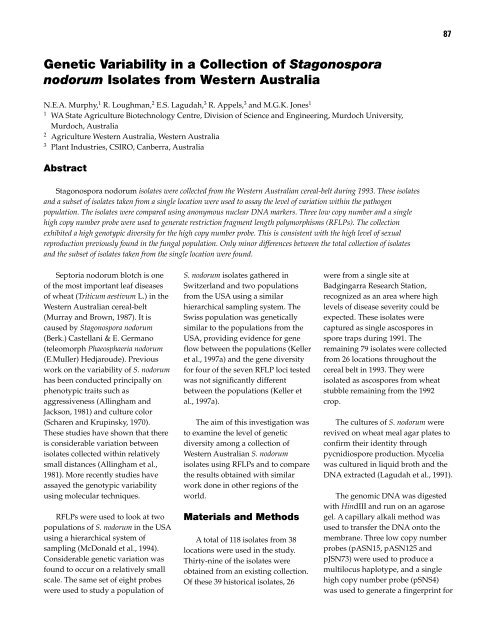Septoria and Stagonospora Diseases of Cereals - CIMMYT ...
Septoria and Stagonospora Diseases of Cereals - CIMMYT ...
Septoria and Stagonospora Diseases of Cereals - CIMMYT ...
Create successful ePaper yourself
Turn your PDF publications into a flip-book with our unique Google optimized e-Paper software.
Genetic Variability in a Collection <strong>of</strong> <strong>Stagonospora</strong><br />
nodorum Isolates from Western Australia<br />
N.E.A. Murphy, 1 R. Loughman, 2 E.S. Lagudah, 3 R. Appels, 3 <strong>and</strong> M.G.K. Jones1 1 WA State Agriculture Biotechnology Centre, Division <strong>of</strong> Science <strong>and</strong> Engineering, Murdoch University,<br />
Murdoch, Australia<br />
2 Agriculture Western Australia, Western Australia<br />
3 Plant Industries, CSIRO, Canberra, Australia<br />
Abstract<br />
<strong>Stagonospora</strong> nodorum isolates were collected from the Western Australian cereal-belt during 1993. These isolates<br />
<strong>and</strong> a subset <strong>of</strong> isolates taken from a single location were used to assay the level <strong>of</strong> variation within the pathogen<br />
population. The isolates were compared using anonymous nuclear DNA markers. Three low copy number <strong>and</strong> a single<br />
high copy number probe were used to generate restriction fragment length polymorphisms (RFLPs). The collection<br />
exhibited a high genotypic diversity for the high copy number probe. This is consistent with the high level <strong>of</strong> sexual<br />
reproduction previously found in the fungal population. Only minor differences between the total collection <strong>of</strong> isolates<br />
<strong>and</strong> the subset <strong>of</strong> isolates taken from the single location were found.<br />
<strong>Septoria</strong> nodorum blotch is one<br />
<strong>of</strong> the most important leaf diseases<br />
<strong>of</strong> wheat (Triticum aestivum L.) in the<br />
Western Australian cereal-belt<br />
(Murray <strong>and</strong> Brown, 1987). It is<br />
caused by <strong>Stagonospora</strong> nodorum<br />
(Berk.) Castellani & E. Germano<br />
(teleomorph Phaeosphaeria nodorum<br />
(E.Muller) Hedjaroude). Previous<br />
work on the variability <strong>of</strong> S. nodorum<br />
has been conducted principally on<br />
phenotypic traits such as<br />
aggressiveness (Allingham <strong>and</strong><br />
Jackson, 1981) <strong>and</strong> culture color<br />
(Scharen <strong>and</strong> Krupinsky, 1970).<br />
These studies have shown that there<br />
is considerable variation between<br />
isolates collected within relatively<br />
small distances (Allingham et al.,<br />
1981). More recently studies have<br />
assayed the genotypic variability<br />
using molecular techniques.<br />
RFLPs were used to look at two<br />
populations <strong>of</strong> S. nodorum in the USA<br />
using a hierarchical system <strong>of</strong><br />
sampling (McDonald et al., 1994).<br />
Considerable genetic variation was<br />
found to occur on a relatively small<br />
scale. The same set <strong>of</strong> eight probes<br />
were used to study a population <strong>of</strong><br />
S. nodorum isolates gathered in<br />
Switzerl<strong>and</strong> <strong>and</strong> two populations<br />
from the USA using a similar<br />
hierarchical sampling system. The<br />
Swiss population was genetically<br />
similar to the populations from the<br />
USA, providing evidence for gene<br />
flow between the populations (Keller<br />
et al., 1997a) <strong>and</strong> the gene diversity<br />
for four <strong>of</strong> the seven RFLP loci tested<br />
was not significantly different<br />
between the populations (Keller et<br />
al., 1997a).<br />
The aim <strong>of</strong> this investigation was<br />
to examine the level <strong>of</strong> genetic<br />
diversity among a collection <strong>of</strong><br />
Western Australian S. nodorum<br />
isolates using RFLPs <strong>and</strong> to compare<br />
the results obtained with similar<br />
work done in other regions <strong>of</strong> the<br />
world.<br />
Materials <strong>and</strong> Methods<br />
A total <strong>of</strong> 118 isolates from 38<br />
locations were used in the study.<br />
Thirty-nine <strong>of</strong> the isolates were<br />
obtained from an existing collection.<br />
Of these 39 historical isolates, 26<br />
87<br />
were from a single site at<br />
Badgingarra Research Station,<br />
recognized as an area where high<br />
levels <strong>of</strong> disease severity could be<br />
expected. These isolates were<br />
captured as single ascospores in<br />
spore traps during 1991. The<br />
remaining 79 isolates were collected<br />
from 26 locations throughout the<br />
cereal belt in 1993. They were<br />
isolated as ascospores from wheat<br />
stubble remaining from the 1992<br />
crop.<br />
The cultures <strong>of</strong> S. nodorum were<br />
revived on wheat meal agar plates to<br />
confirm their identity through<br />
pycnidiospore production. Mycelia<br />
was cultured in liquid broth <strong>and</strong> the<br />
DNA extracted (Lagudah et al., 1991).<br />
The genomic DNA was digested<br />
with HindIII <strong>and</strong> run on an agarose<br />
gel. A capillary alkali method was<br />
used to transfer the DNA onto the<br />
membrane. Three low copy number<br />
probes (pASN15, pASN125 <strong>and</strong><br />
pJSN73) were used to produce a<br />
multilocus haplotype, <strong>and</strong> a single<br />
high copy number probe (pSNS4)<br />
was used to generate a fingerprint for









